Wi-Fi 6's OFDMA Challenges Make Verification Crucial
By Eve Danel, LitePoint

Next-generation Wi-Fi — dubbed Wi-Fi 6 and based on the IEEE 802.11ax standard — promises greater capacity and more robust data transmission than previous Wi-Fi standards. Designed to improve capacity in environments with many connected devices, such as stadiums and other public venues, Wi-Fi 6 provides a nearly fourfold increase in user and system capacity over earlier generations.
According to industry experts, Wi-Fi 6’s most significant technology advance comes from the introduction of Orthogonal Frequency Division Multiple Access (OFDMA) modulation. OFDMA is a multi-user version of Orthogonal Frequency Division Multiplexing (OFDM) used in earlier WLAN generations, where the Wi-Fi channel is divided among multiple users that can simultaneously exchange data with the access point using smaller sub-channels (Fig. 1).
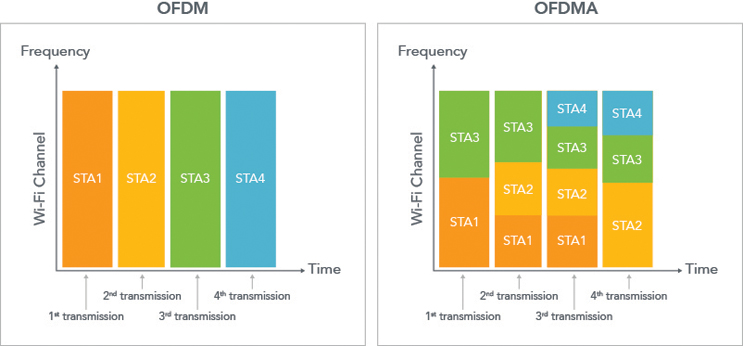
Fig. 1 — OFDM vs. OFDMA modulation
Wi-Fi 6 relies on OFDMA technology to achieve greater capacity and lower latency in environments with high device density. But, with multiple devices sharing the spectrum and transmitting simultaneously, one bad actor can ruin the transmission for all other devices in the network. While OFDMA has long been in use in 4G/LTE networks, it is the first time it is being applied to the crowded and chaotic unlicensed bands in which Wi-Fi operates. More than ever, verification of compliance to the standard is needed to ensure that access points and client stations interoperate and work well together.
What is OFDMA and why does it matter?
Older 802.11 a/b/g/n/ac generations were based on OFDM modulation, where increases in channel bandwidth (20, 40, 80, or 160 MHz wide) provided more bandwidth, but each channel was fully reserved to a single user for each transmission.
In contrast, OFDMA modulation divides the 802.11 channel into sub-channels, also known as Resource Units (RU). A 160 MHz channel can be divided into up to 74 separate RUs, where each RU can be assigned to a different client station (Fig. 2). The size and number of RUs allocated to each station is assigned by the Wi-Fi access point based on the station’s data transmission requirements.
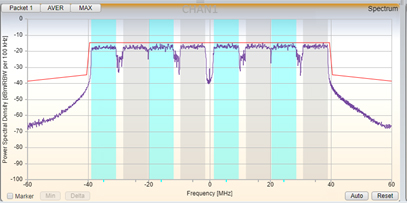
Fig. 2 — OFDMA transmission showing 80 MHz channel divided into eight RUs
This transmission scheme provides great benefits in congested environments where many users can now share the channel, leading to a more efficient use of the available spectrum.
With OFDMA, the access point plays a central role, acting as an “orchestra conductor.” It is responsible for assigning the sub-channel allocation to the various Wi-Fi stations and for synchronizing their transmissions.
In the downlink direction, the transmission from the access point (DL-OFDMA) bundles together data destined for multiple stations on their respective RU sub-channels. The client station devices tune their radios to receive their respective data on their assigned RU.
In the uplink direction (UL-OFDMA), traffic is transmitted from the client stations to the access point. The process described above is reversed: as multiple stations transmit simultaneously on their respective pre-assigned RUs, the access point is in charge of coordinating simultaneous transmissions from the client stations. This synchronization is done by the transmission of a trigger frame. In response to the trigger frame, the client stations have to tune their timing, frequency, and power to participate in the upcoming transmission.
How does OFDMA challenge Wi-Fi 6 networks?
The accuracy of time, frequency, and power synchronization between the Wi-Fi access point and client stations determines the overall network capacity. When multiple users share the available spectrum, interference from a single bad actor can degrade network performance for all other users. Verification of compliance for access points and client stations to Wi-Fi 6 standard is a critical step for optimal deployments.
Timing synchronization — Client stations participating in an OFDMA transmission must transmit within 400 ns of each other. To synchronize the clients, the access point transmits a trigger frame. This frame contains information about the OFDMA sub-carrier’s RU assigned to each station. In response, the participating clients need to start transmission of the uplink signal after a specified time interval short inter-frame space (SIFS) of 16 µs +/- 400 ns after the end of the trigger frame, as mandated by the 802.11ax standard.
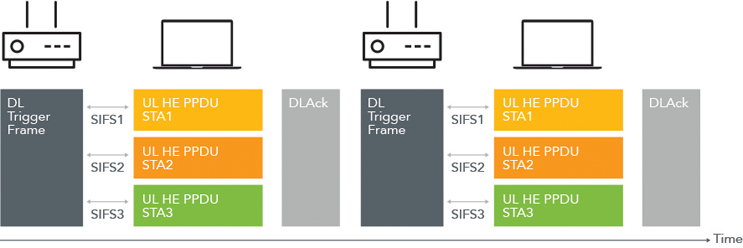
Fig. 3 — Timing synchronization of Uplink OFDMA
Frequency synchronization — To prevent inter-carrier interference (ICI) between the clients transmitting simultaneously, all stations participating in the transmission need to pre-compensate for carrier frequency offset (CFO). Each client station adjusts its carrier frequency based on the trigger frame received from the access point. The 802.11ax standard requires a residual CFO error after compensation less than 350 Hz.
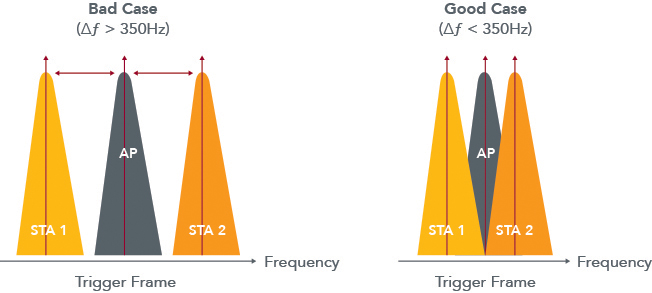
Fig. 4 — Wi-Fi OFDMA Frequency Synchronization
Power control — When traffic is transmitted between the access point and client stations located at various distances, power control is needed to ensure that stations closer to the access point do not drown out users farther away. Thus, the 802.11ax standard requires the stations to adjust their power based on the estimated path loss to the access point: devices closer to the access point transmit less power, while devices farther away transmit more power in order to achieve the same power level at the access point receiver.
Two classes of device are defined in the standard, based on how accurately they can control their power. Class A devices control their transmit power within ±3 dB, while class B devices control their power within ±9 dB.
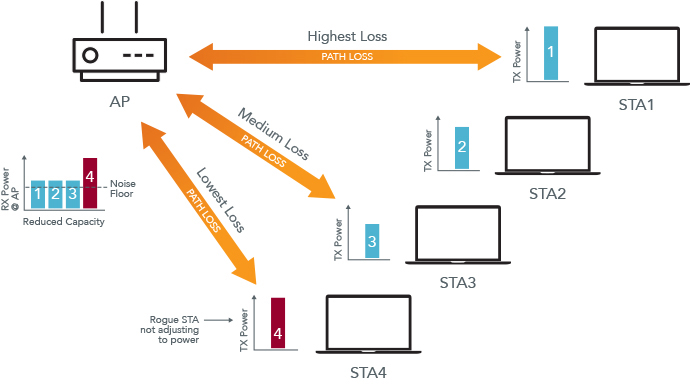
Fig. 5 — Wi-Fi OFDMA Power Control
Ensuring Wi-Fi 6 equipment complies with the standard
To realize Wi-Fi 6’s benefits of greater capacity and lower latency, compliant products need to achieve a level of precision in timing (+/- 400ns), frequency (+/- 350 Hz), and power level control (+/- 3dB) never before required of Wi-Fi devices. Therefore, engineers developing and validating next-generation devices will need a set of capabilities not before required from Wi-Fi test equipment.
The verification of access point and station compliance with 802.11ax OFDMA requirements needs real-time capture and analysis of traffic at the physical layer (RF) and protocol layer (MAC), as well as high-precision parametric measurements of timing, frequency, and power for each RU (sub-channel) involved in the transmission. Both uplink and downlink traffic directions need to be monitored and analyzed to detect interactions between access point and client stations.
With multiple devices sharing the spectrum and transmitting simultaneously, verification of compliance is a crucial step toward ensuring the success of Wi-Fi 6 deployments.
Conclusion
Wi-Fi 6 is rolling out at a fast pace: a report from the Wireless Broadband Alliance states that 66 percent of respondents from over 200 telecommunications service providers, technology vendors, and enterprises already have deployed, or are planning to deploy, Wi-Fi 6 before the end of 2020.
This new technology’s success relies largely on devices’ ability to interoperate and work well together. To this end, the Wi-Fi Alliance recently launched the Wi-Fi Certified 6 program, designed to distinguish Wi-Fi 6 products that meet the highest standards for security and interoperability. Key to this initiative is OFDMA technology, whose functionality must be verified if users are to achieve greater capacity and lower latency in environments with high device density
About the Author
 Eve Danel is a Senior Product Marketing Manager at LitePoint responsible for wireless connectivity test systems. Eve has over 15 years of experience working in test and measurement companies. Prior to joining LitePoint, she was a Senior Product Manager VeEx inc. responsible for Wi-Fi and Ethernet network test solutions. Eve holds an MS degree in Digital Signal Processing from San Jose State University.
Eve Danel is a Senior Product Marketing Manager at LitePoint responsible for wireless connectivity test systems. Eve has over 15 years of experience working in test and measurement companies. Prior to joining LitePoint, she was a Senior Product Manager VeEx inc. responsible for Wi-Fi and Ethernet network test solutions. Eve holds an MS degree in Digital Signal Processing from San Jose State University.
